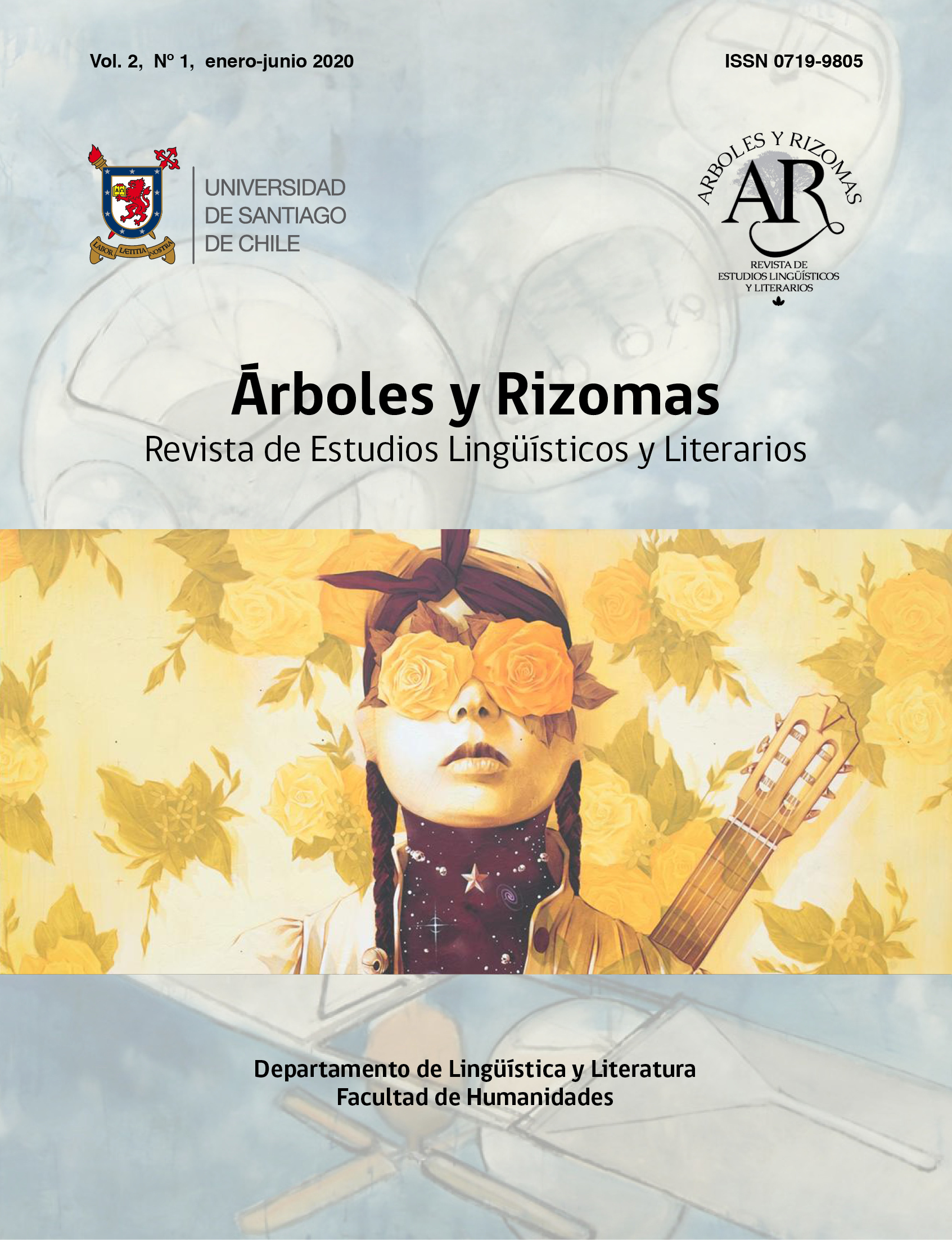Towards an intersemiotic conception of Violeta Parra's artistic translation
DOI:
https://doi.org/10.35588/ayr.v2i1.4459Keywords:
translation, poetics, intersemiotic translation, Violeta Parra, Roman JakobsonAbstract
Violeta Parra's interdisciplinary work has had less scholarly attention than it deserves, being one of the first Chilean artists to paint her songs as shown in her painting Casamiento de negros. In fact, much of her artistic activity, of translating a text, shows a broad and surprising relationship with the regular practice of [linguistic] translation; from the act of ‘translating’ the ‘spoken text’ as G. Soublette calls Cantos Folklóricos Chilenos, to the practice of translating songs and texts into French during her European performances and exhibitions. This article aims to approach and analyse this interdisciplinary practice of Violeta Parra (VP) following some literary and linguistic studies, from the Aristotelian notion of poetics, a brief reference is made to Neruda's poetical translation whose influence could have had resonance in VP's work. Using the concept of ‘intersemiotic translation’, the main criticism of Umberto Eco in relation to the distinction between translator and interpreter is discussed to finally posit the concept of poetic transposition to understand and demonstrate this practice widely developed by the Chilean artist.
Downloads
References
Agosín, M., & Dölz-Blackburn, I. (1992). Violeta Parra, o La expresión inefable: Un análisis crítico de su poesía, prosa, y pintura. Santiago de Chile: Planeta.
Aristotle. (1922). The poetics of Aristotle (S. H. Butcher, Ed.). London: Macmillan and Co.
Aubrey, E. (2000). The music of the troubadours. Bloomington: Indiana University Press.
Bellos, D. (2011). Is that a fish in your ear?: Translation and the meaning of everything. London: Penguin.
Benjamin, W. (2004). Selected writings (M. P. Bullock & M. W. Jennings, Eds.). Cambridge, Mass.: Belknap Press of Harvard University Press.
Bruhn, S. (2001). A concert of paintings: "Musical ekphrasis” in the twentieth century. Poetics today, 22, 3, 551–605.
Brunhammer, Y. (1964). Violeta Parra: Musée des arts décoratifs, Louvre. [catálogo exposición] Paris: Musée des arts décoratifs, Louvre.
Dillon, L. (2013). Violeta Parra’s Visual Art (PhD). King’s College London, London.
Eco, U. (1979). A Theory of Semiotics. Bloomington: Indiana University Press.
Eco, U. (2004). Mouse or Rat? Translation as Negotiation. London, Phoenix.
Escobar-Mundaca, A. (2012). Violeta Parra, una aproximación a la creación interdisciplinaria (Masters). Universitat de Barcelona, Barcelona.
Escobar-Mundaca, A. (2018). I Don’t Play the Guitar for Applause: Turning the World Upside Down. En Mapping Violeta Parra’s Cultural Landscapes (pp. 57–71). Cham: Palgrave Macmillan.
Escobar-Mundaca, A. (2019). Translating poetics: Analysing the connections between Violeta Parra’s music, poetry and art (PhD Thesis). University of Sussex.
Farias, M. (1993). Violeta Parra: A semiotic reading of a popular voice. (PhD). The Catholic University of America, Washington, D.C.
García Canclini, N. (1989). Culturas híbridas: Estrategias para entrar y salir de la modernidad. México DF: Grijalbo.
Greene, R., Cushman, S., Cavanagh, C., Ramazani, J., Rouzer, P., Feinsod, H., € Slessarev, A. (2012). The Princeton encyclopedia of poetry and poetics. Princeton, NJ: Princeton University Press.
Jakobson, R. (1987). Language in literature (K. Pomorska & S. Rudy, Eds.). London: Harvard University Press.
Kennedy, M., & Bourne, J. (2004). The Concise Oxford Dictionary of Music. Oxford: Oxford University Press.
Méndez-Ramírez, H. (1999). Neruda’s Ekphrastic Experience: Mural Art and Canto General. Lewisburg, Penn.: Bucknell University Press.
Miranda, P. (2001). Las décimas de Violeta Parra: Autobiografía y uso de la tradición discursiva (Masters). Universidad de Chile, Santiago de Chile.
Montealegre, J. (2011). Violeta Parra. Santiago de Chile: USACH.
Morales, L. (2003). Violeta Parra: La última canción. Santiago de Chile: Editorial Cuarto Propio.
Navasal, M. de. (1954). Conozca a Violeta Parra. ECRAN, 1220, 18–20.
Neruda, P. (1993). Canto general (J. Schmitt, Trad.). Berkeley: University of California Press.
Neruda, P. (2011). Confieso que he vivido. Madrid: Planeta.
Newton, K. M. (1997). Twentieth-century literary theory. London: Palgrave.
Oporto, L. (2013). El diablo en la música. La muerte del amor en El gavilán, de Violeta Parra. Santiago de Chile: USACH.
Parra, F. V. (2008). Violeta Parra: Obra visual (2a ed.). Santiago de Chile: Fundación Violeta Parra.
Parra, I. (2011). El libro mayor de Violeta Parra (2a.). Santiago de Chile: Cuarto Propio.
Parra, V. (1957). Violeta Parra. El Folklore de Chile Vol. I [LP 12” / 33 â…“ RPM / mono]. Santiago de Chile: ODEON - LDC-36019.
Parra, V. (1958). Violeta Parra. El Folklore de Chile Vol.II. [LP 12” / 33 â…“ RPM / mono]. Santiago de Chile: Odeón LDC-36025.
Parra, V. (1959). La Cueca Presentada Por Violeta [LP 12” / 33 â…“ RPM / mono]. Santiago de Chile: ODEON - LDC-36038.
Parra, V. (1965). Poésie populaire des Andes (Vol. 12). Paris: F. Maspero.
Parra, V. (1976). Décimas [LP 12” / 33 â…“ RPM / mono /]. Santiago de Chile: Alerce ALP-204.
Parra, V. (1998). Décimas: Autobiografía en versos. Buenos Aires: Sudamericana.
Parra, V. (1999). Violeta Parra en Ginebra [2 CD / Reissue]. Santiago, Chile: Warner Music Chile.
Parra, V. (2013). Cantos folklóricos chilenos. Santiago de Chile: CEIBO.
Peirce, C. S. (1933). Collected papers of Charles Sanders Peirce. (P. Weiss & C. Hartshorne, Eds.). Cambridge, Mass.: Harvard University Press.
Peirce, C. S. (1998). The Essential Peirce: Selected Philosophical Writings. Indiana University Press.
Pinochet, C. (2007). Violeta Parra: Hacia un imaginario del mundo subalterno (Licenciatura). Universidad de Chile, Santiago de Chile.
Ulloa, D. (1997). Neruda: Humilde traductor. Atenea (Concepción): revista de ciencias, artes y letras, 476, 85–101.
Uribe, C. (2002). Violeta Parra: En la frontera del arte musical chileno. Intramuros, 9, 8–14.
Vicuña, M. (1958). Violeta Parra, hermana mayor de los poetas populares. Revista Musical Chilena, 12, 60, 71–77.






